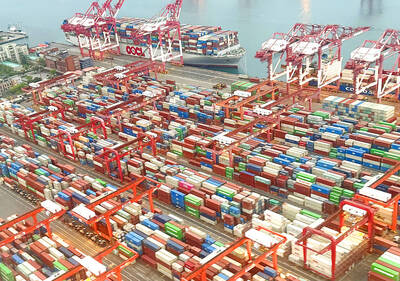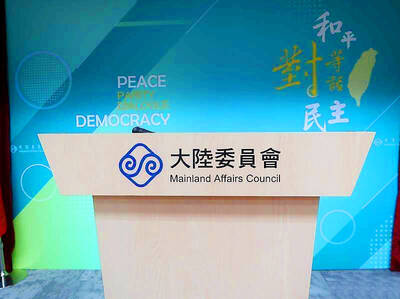Even as Britain, following a detailed review, mulls the need for increased nuclear capacity, Spain has the bit between its teeth as it champions renewable energy.
Spain is in the EU renewables vanguard as the EU targets a 20 percent share of overall energy production by 2010, compared with a projected 3 percent for Japan.
Wind farms are a major part of the national strategy and the share of overall wind farm-generated production is set to double to 12 percent over the next four years -- giving some 20,000 megawatts (MW) of installed capacity.
While such comparisons are not precise, in the US, 1MW of wind power generates about as much electricity as 240-300 homes use, according to the American Wind Energy Association.
Currently, Spain, where the energy market was deregulated in 1998, is second only to Germany and just ahead of the US in terms of installed wind power capacity, at 8,155MW in December 2004, compared with 14,000MW for Germany.
Analysts say Chinese capacity could hit 30 gigawatts (GW or 30,000MW) by 2020, underscoring Spanish interest in that market.
Solar power is also on the rise, with Spain's photovoltaic association ASIF forecasting growth of up to 1,100MW by 2010, exceeding government forecasts more than twice over.
Spain's first polysilicon solar plant came on stream only last month on the outskirts of the southern city of Cadiz.
Iberdrola, Spain's second largest indigenous producer of electricity, said on Thursday that a surge in its renewable energy business had helped lift first-half net profit by 25 percent to 817.8 million euros (US$1 billion), well above forecasts.
Earlier, the firm announced it had raised its stake in the Spanish wind farm specialist Gamesa to 17 percent as part of a move to focus its interests on renewable sources.
According to financial director Jose Sainz Armada, Iberdrola expects production at its renewable energy division to grow "by 10-12 percent in the second half of this year."
The wind generated portion of the firm's energy output is barely 14 percent of the 27,993MW total at present, but Iberdrola says the target is to lift that to nearer 33 percent for a total 10,000MW by 2011.
The link up with Gamesa "is seen as an important plank in a renewables strategy whose growing importance cannot be underestimated," an energy analyst at a leading European bank said on Friday.
Gamesa has become a trailblazer in recent years, exporting its wind technology to China, the US and France.
The company is the second-biggest producer of wind turbines in the world behind Danish rival Vestas Wind Systems and won orders last year to install 520 wind turbines worth 234 million euros.
More than half of those were from China, where Gamesa already covers 36 percent of the renewable energy market.
Iberdrola itself recently bought out US operator Community Energy (CEI) and agreed to take a 29 percent stake in China's Guanxi Guidong Electric.
The Spanish group is also tackling renewables projects from Britain to Brazil and has 16,000MW worth of projects in China, the US and France alone.
"That makes us the biggest wind energy producer in the world," the firm claims.
Regarding nuclear power, Spain has nine plants in operation that account for 23 percent of all energy production, a level comparable with the US and Britain but far behind France's 78 percent.
Increasing that level however is a political hot potato, as elsewhere.
Britain's energy review last week flagged the need to develop renewable sources although Prime Minister Tony Blair said in May that nuclear energy was "back on the agenda with a vengeance" amid the need to slash greenhouse gas emissions by 20 percent of their 1990 levels between now and 2010.
Spain, which depends heavily on imported supplies of oil and gas, last year unveiled a Renewable Energy Plan.
The plan offers tax incentives for firms that employ clean emission technologies, and sees 97 percent of a total 23.6 billion euro investment coming from the private sector.
While not all environmentalists are convinced, wildlife officials at a bird sanctuary in the Ebro Delta were appalled to hear of a wind farm project for the area, a 2003 Greenpeace (France) report favorably compared the wind route with the prospect of greater reliance on nuclear power.
That report quoted the European Wind Energy Association as saying that by 2010, installed wind capacity could equal the output of 14 nuclear reactors.
In a world which uses more than 300 billion kilowatt-hours of energy a day and rising, the rush to renewables shows no sign of abating.
"Renewable sources can help to bridge the gap in the European energy supply ... and contribute to sustainable development," a report by the EU Barometer of Renewable Energies said recently.

MORE VISITORS: The Tourism Administration said that it is seeing positive prospects in its efforts to expand the tourism market in North America and Europe Taiwan has been ranked as the cheapest place in the world to travel to this year, based on a list recommended by NerdWallet. The San Francisco-based personal finance company said that Taiwan topped the list of 16 nations it chose for budget travelers because US tourists do not need visas and travelers can easily have a good meal for less than US$10. A bus ride in Taipei costs just under US$0.50, while subway rides start at US$0.60, the firm said, adding that public transportation in Taiwan is easy to navigate. The firm also called Taiwan a “food lover’s paradise,” citing inexpensive breakfast stalls

TRADE: A mandatory declaration of origin for manufactured goods bound for the US is to take effect on May 7 to block China from exploiting Taiwan’s trade channels All products manufactured in Taiwan and exported to the US must include a signed declaration of origin starting on May 7, the Bureau of Foreign Trade announced yesterday. US President Donald Trump on April 2 imposed a 32 percent tariff on imports from Taiwan, but one week later announced a 90-day pause on its implementation. However, a universal 10 percent tariff was immediately applied to most imports from around the world. On April 12, the Trump administration further exempted computers, smartphones and semiconductors from the new tariffs. In response, President William Lai’s (賴清德) administration has introduced a series of countermeasures to support affected

CROSS-STRAIT: The vast majority of Taiwanese support maintaining the ‘status quo,’ while concern is rising about Beijing’s influence operations More than eight out of 10 Taiwanese reject Beijing’s “one country, two systems” framework for cross-strait relations, according to a survey released by the Mainland Affairs Council (MAC) on Thursday. The MAC’s latest quarterly survey found that 84.4 percent of respondents opposed Beijing’s “one country, two systems” formula for handling cross-strait relations — a figure consistent with past polling. Over the past three years, opposition to the framework has remained high, ranging from a low of 83.6 percent in April 2023 to a peak of 89.6 percent in April last year. In the most recent poll, 82.5 percent also rejected China’s

PLUGGING HOLES: The amendments would bring the legislation in line with systems found in other countries such as Japan and the US, Legislator Chen Kuan-ting said Democratic Progressive Party (DPP) Legislator Chen Kuan-ting (陳冠廷) has proposed amending national security legislation amid a spate of espionage cases. Potential gaps in security vetting procedures for personnel with access to sensitive information prompted him to propose the amendments, which would introduce changes to Article 14 of the Classified National Security Information Protection Act (國家機密保護法), Chen said yesterday. The proposal, which aims to enhance interagency vetting procedures and reduce the risk of classified information leaks, would establish a comprehensive security clearance system in Taiwan, he said. The amendment would require character and loyalty checks for civil servants and intelligence personnel prior to